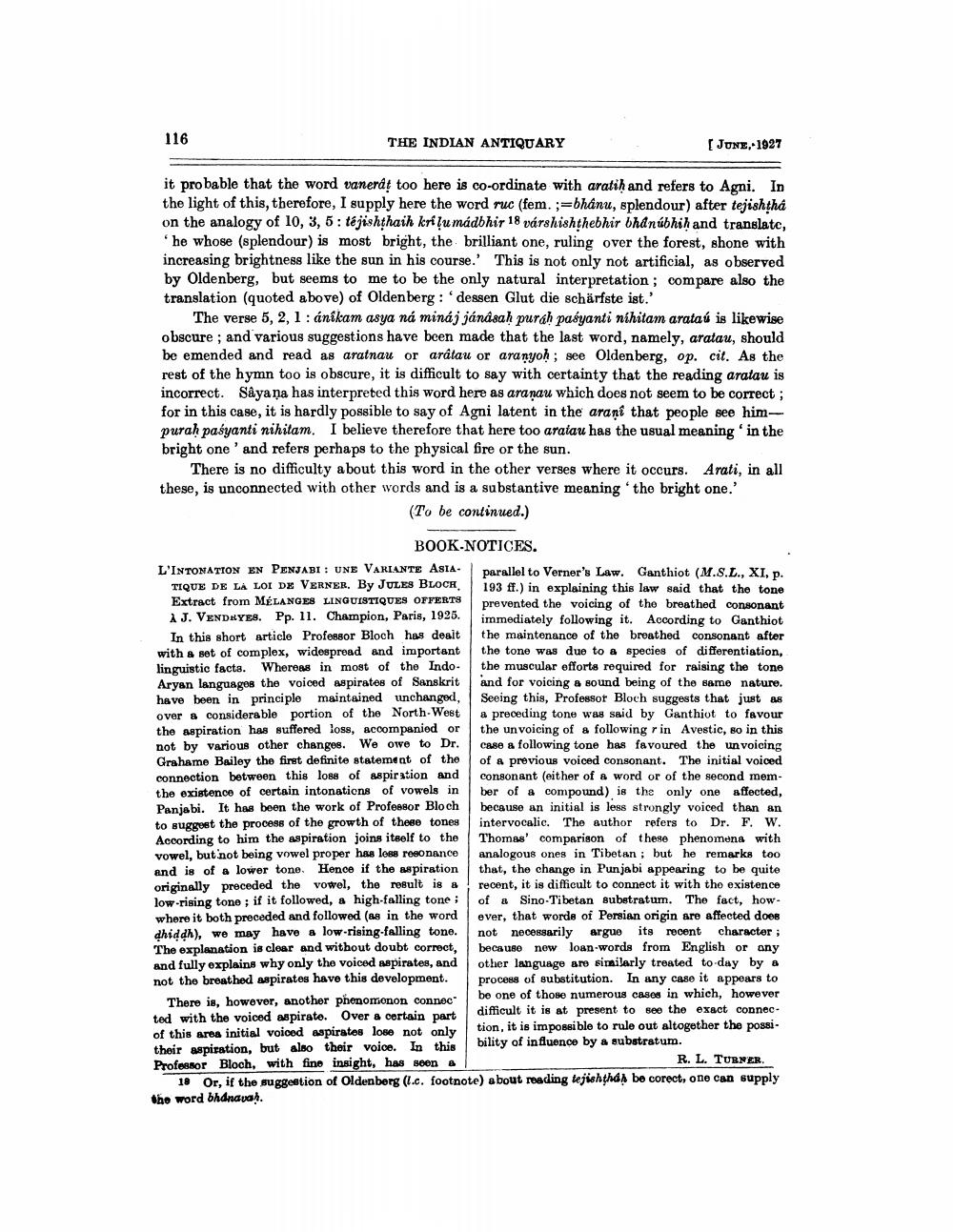________________
116
THE INDIAN ANTIQUARY
[JUNE, 1927
it probable that the word vanerat too here is co-ordinate with aratih and refers to Agni. In the light of this, therefore, I supply here the word ruc (fem. ;=bhanu, splendour) after tejishtha on the analogy of 10, 3, 5 : té jishthaih krilu mádbhir 18 varshishthebhir bhanubhih and translate,
he whose (splendour) is most bright, the brilliant one, ruling over the forest, shone with increasing brightness like the sun in his course. This is not only not artificial, as observed by Oldenberg, but seems to me to be the only natural interpretation; compare also the translation (quoted above) of Oldenberg : dessen Glut die schärfste ist.'
The verse 5, 2,1 : ánikam asya ná minaj jánásah purah pasyanti nihitam arataú is likewise obscure ; and various suggestions have been made that the last word, namely, aratau, should be emended and read as aratnau or aratau or aranyoh; see Oldenberg, op. cit. As the rest of the hymn too is obscure, it is difficult to say with certainty that the reading aratau is incorrect. Saya na has interpreted this word here as aranau which does not seem to be correct; for in this case, it is hardly possible to say of Agni latent in the arani that people see himpurah paśyanti nihitam. I believe therefore that here too aratau has the usual meaning in the bright one' and refers perhaps to the physical fire or the sun.
There is no difficulty about this word in the other verses where it occurs. Arati, in all these, is unconnected with other words and is a substantive meaning the bright one.'
(To be continued.)
BOOK-NOTICES. L'INTONATION EN PENJABI : UNE VARIANTE ASIA- parallel to Verner's Law. Ganthiot (M.S.L., XI, p. TIQUE DE LA LOI DE VERNER. By JULES BLOCH
193 fr.) in explaining this law said that the tone Extract from MÉLANGES LINGUISTIQUES OFFERTS
prevented the voicing of the breathed consonant AJ. VENDRYES. Pp. 11. Champion, Paris, 1926.
immediately following it. According to Ganthiot In this short article Professor Bloch has dealt the maintenance of the breathed consonant after with a set of complex, widespread and important the tone was due to a species of differentiation, linguistic facta. Whereas in most of the Indo- the muscular efforts required for raising the tone Aryan languages the voiced aspirates of Sanskrit and for voicing & sound being of the same nature. have been in principle maintained unchanged, Seeing this, Professor Bloch suggests that just as over a considerable portion of the North-West a preceding tone was said by Ganthiot to favour the aspiration has suffered loss, accompanied or the unvoicing of a following rin Avestic, so in this not by various other changes. We owe to Dr. case a following tone has favoured the unvoicing Grahame Bailey the first definite statement of the of a previous voiced consonant. The initial voiced connection between this loss of aspiration and consonant (either of a word or of the second memthe existence of certain intonations of vowels in ber of a compound) is the only one affected, Panjabi. It has been the work of Professor Bloch because an initial is less strongly voiced than an to suggost the process of the growth of these tones
intervocalic. The author refers to Dr. F. W. According to him the aspiration joins itself to the Thomas' comparison of these phenomena with vowel, but not being vowel proper has less resonance analogous ones in Tibetan; but he remarks too and is of a lower tone. Hence if the aspiration that, the change in Punjabi appearing to be quite originally preceded the vowel, the result is #! recent, it is difficult to connect it with the existence low-rising tone ; if it followed, a high-falling tone ; of & Sino-Tibetan substratum. The fact, howwhere it both preceded and followed (as in the word ever, that worde of Persian origin are affected does dhiddh), we may have a low-rising-falling tone. not necessarily ergue its recent character ; The explanation is clear and without doubt correct, because now loan-words from English or any and fully explains why only the voiced aspirates, and other language are similarly treated to day by a not the breathed aspirates have this development. process of substitution. In any case it appears to There is, however, another phenomonon connec
be one of those numerous cases in which, however ted with the voiced aspirato. Over & certain part
difficult it is at present to see the exact connecof this area initial voiced aspirates lose not only
tion, it is impossible to rule out altogether the possitheir aspiration, but also their voice. In this
bility of influence by a substratum. Professor Bloch, with fine insight, has seen &
R. L. TUBNER. 19 Or, if the suggestion of Oldenberg (l.c. footnote) about reading tejishthaa bo corect, one can supply the word bhdnaval.




